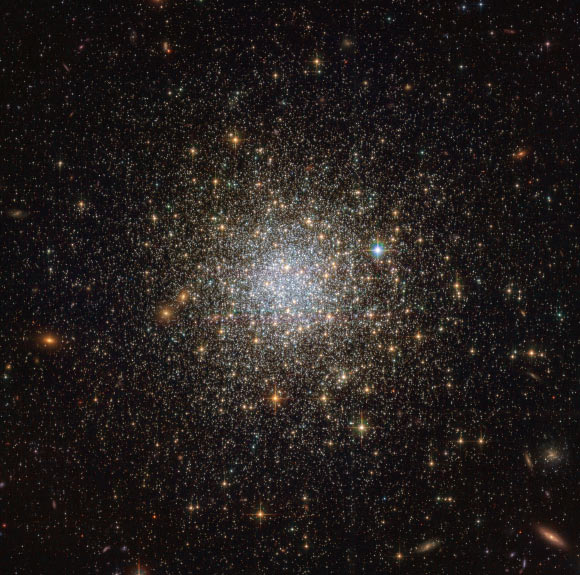Hubble Observes Five Aging Star Clusters in Large Magellanic Cloud | Astronomy – Sci-News.com
A team of astronomers from Italy and Germany has used the NASA/ESA Hubble Space Telescope to observe five aging star clusters — all born at about the same time but with different sizes — in the Large Magellanic Cloud, a satellite galaxy of our Milky Way Galaxy that lies about 160,000 light-years distant. The researchers have succeeded in ranking these clusters in terms of the level of dynamical evolution, which affects their shape.

This Hubble image reveals an ancient, glimmering ball of stars called NGC 1466. It is a globular cluster that is slowly moving through space on the outskirts of the Large Magellanic Cloud. NGC 1466 has a mass equivalent to roughly 140,000 Suns and an age of around 13.1 billion years, making it almost as old as the Universe itself. Image credit: NASA / ESA / Hubble.
Star clusters are aggregates of many — up to one million — stars. They are active systems in which the mutual gravitational interactions among the stars change their structure over time — known to astronomers as ‘dynamical evolution.’
Because of such interactions, heavy stars tend to progressively sink towards the central region of a star cluster, while low-mass stars can escape from the system.
This causes a progressive contraction of the cluster core over different timescales and means that star clusters with the same chronological age can vary greatly in appearance and shape because of their different dynamical ages.
The Large Magellanic Cloud hosts star clusters covering a wide range of ages. This differs from our Milky Way Galaxy which primarily contains older star clusters.
The distribution of sizes as a function of age observed for star clusters in the Large Magellanic Cloud is very puzzling, as the young clusters are all compact, while the oldest systems have both small and large sizes.
All star clusters, including those in the small galaxy, have been found to host a special type of re-invigorated stars called blue stragglers.
Under certain circumstances, stars receive extra fuel that bulks them up and substantially brightens them. This can happen if one star pulls matter off a neighbor, or if they collide.
As a result of dynamical aging, heavier stars sink towards the centre of a cluster as the cluster ages, in a process similar to sedimentation, called ‘central segregation.’
Blue stragglers are bright, making them relatively easy to observe, and they have high masses, which means that they are affected by central segregation and can be used to estimate the dynamical age of a star cluster.
Dr. Francesco Ferraro, an astronomer with the University of Bologna, and colleagues used Hubble to observe blue stragglers in five old Large Magellanic Cloud star clusters with different sizes and succeeded in ranking them in terms of their dynamical age.
“We demonstrated that different structures of star clusters are due to different levels of dynamical ageing: they are in different physical shape despite the fact that they were born at the same cosmic time,” Dr. Ferraro said.
“This is the first time that the effect of dynamical ageing has been measured in the Large Magellanic Cloud clusters.”
“These findings present intriguing areas for further research, since they reveal a novel and valuable way of reading the observed patterns of star clusters in the Large Magellanic Cloud, providing new hints about the cluster formation history in this galaxy,” said Dr. Barbara Lanzoni, also from the University of Bologna.
The results were published in the journal Nature Astronomy.
_____
F.R. Ferraro et al. Size diversity of old Large Magellanic Cloud clusters as determined by internal dynamical evolution. Nature Astronomy, published online September 9, 2019; doi: 10.1038/s41550-019-0865-1





